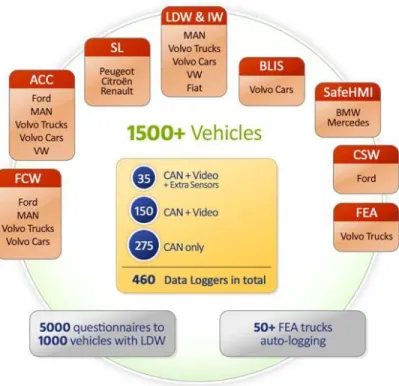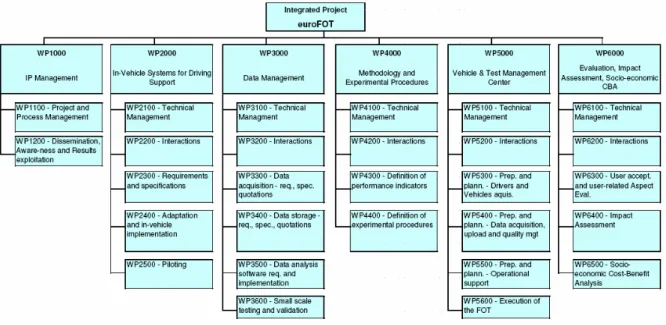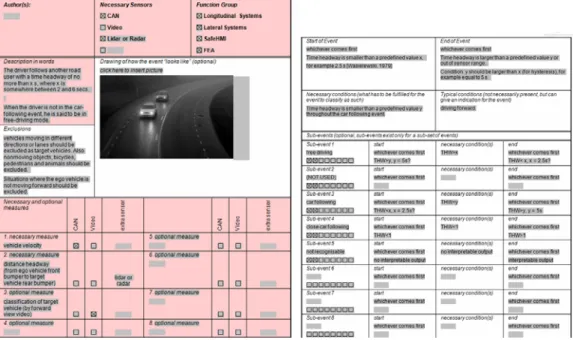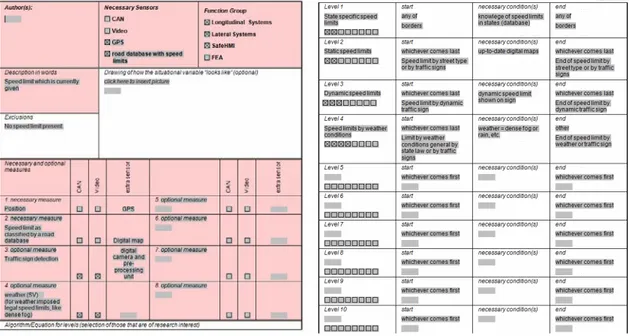1
METHODOLOGICAL CHALLENGES AND SOLUTIONS IN
THE EUROFOT PROJECT
Samantha Jamson1, Katja Kircher2 and Rino Brouwer3* 1
Institute for Transport Studies, University of Leeds
2 VTI 3*
TNO Human Factors Kampweg 5 3769 DE Soesterberg The Netherlands Tel: + 31 (0) 346 356 439 Email: rino.brouwer@tno.nl ABSTRACT
The euroFOT project is undertaking Field Operational Tests to investigate the effects of eight safety functions. More than 1500 drivers of cars and trucks will participate with the focus being not only on the use of the systems under daily traffic conditions but also their impact on traffic safety, efficiency and environment. In order to do this, a methodology had to be developed that balanced rigorous experimental methods with the practicalities of running a field trial. This paper describes how the methodology for undertaking comparative analysis between the functions was developed, drawing on the FESTA guidelines.
KEYWORDS
2
INTRODUCTION
Road safety, energy efficiency and traffic congestion are major challenges that currently Need to be addressed and the availability of effective Intelligent Vehicle Technologies and their positive impact on traffic safety and efficiency are widely recognised. There is currently little “naturalistic” data, whereby drivers use these technologies in their everyday driving, for extended periods, that allows the benefits to be calculated.
In the EU project euroFOT eight different in-vehicle systems are investigated with respect to safety, environmental and efficiency aspects under normal real life driving conditions (see Figure 1). The tests will take place within a Field Operational Test (FOT) where the
participants do their normal commuting or while working (professional drivers). They are not told when to drive, where to drive or how to drive. They are not told when to use a system, where to use a system or how to use a system. Their normal daily driving behaviour will be unobtrusively recorded under a wide range of driving conditions.
Figure 1 – Overview of systems and data loggers in euroFOT
The advantage of an FOT is that it shows how drivers really use their systems in their daily driving. However the objective of the project is not only to show this but also to assess the impact of the systems on traffic safety, efficiency and environment. An experimental method is required that allows to make such an assessment. In order to do so it is essential to ensure that a comparison can be made in driving with and without systems and that the situations are comparable in order to ascribe any effect to the system under investigation.
3
The workplan of euroFOT is based around three major areas:
i. The first area addresses ‘In vehicle systems for driving support’, the basic tasks of which are to provide close-to-market and on-the-market systems, and to indicate the functionalities and scenarios for the FOT investigations. Here, the relevant research questions will also be identified.
ii. A second area deals with FOT Methodologies and has the main objective of defining and applying a common evaluation framework, both in terms of the data collected and the way in which it is analysed.
iii. The final area, FOT Operation, is dedicated to the management and implementation aspects required to effectively conduct FOT with a large fleet of vehicles, in different countries, and with a variety of conditions.
The way in which these three areas are incorporated into the work plan can be seen in Figure 2.
Figure 2 – euroFOT work plan
This paper deals with the way in which the area of “FOT methodologies” has been undertaken.
Two major methodological challenges have already been addressed within the euroFOT and this paper will focus on presenting the process involved in meeting those challenges.
i. The first relates to how the functions will be compared in terms of dependent variables (i.e. the measurements taken from the vehicle or driver). Deciding what to measure and when, impacts greatly on the impact analysis that can be undertaken at the end of the project.
ii. The second relates to the experimental design adopted in the FOT. For example crucial decision regarding the length of the trial and the collection of baseline data can affect the reliability of the impact analysis.
4
VARIABLES UNDER CONSIDERATION
A major effort within the euroFOT project was to provide implementable definitions of a host of performance indicators, events, and situational variables, in order to ensure high quality data analysis. Within the EU project FESTA, foundations were laid by providing a framework to describe so-called performance indicators (PI). These are “quantitative or qualitative indicators, derived from one or several measures, agreed before carrying out the FOT, expressed as a percentage, index, rate or other value, which are monitored at regular or irregular intervals and can be compared to one or more criteria” (FESTA handbook, p. 29). An example would be the mean time headway during a car following event. This value could be compared to a target time headway or to the mean time headway during another
experimental condition, for example.
These PI are the variables that will mainly be used during data analysis, and it is very important that clear definitions exist, based on measures, that can be obtained from the vehicles included in the studies. Measures are the information logged from sensors, but measures are not comparable in a meaningful way and are necessary to compute the PI. A matrix of measures has been developed.
As indicated in the example above, however, it is not enough to have a clear definition of “mean time headway” alone. It is just as important to be certain that all involved analysts agree on what “during a car following event” means. Within euroFOT, an event is defined as being “something that happens in a specific period of time which is individuated combining (pre-processed) measures according to predefined rules”. This means that an event can be found by scanning through the data and watching for certain data combinations that occur together. An example of the event “Car Following” is shown in Figure 3.
Figure 3 – Template for events (showing Car Following)
The event “car following” occurs when the instrumented vehicle has a time headway of less than e. g. 6 s to the vehicle ahead. This definition is valid for all vehicles participating in
5
euroFOT. This not only allows a consistent analysis of the different systems tested, but it also enables comparisons across countries. It can, for example, be examined how much more often vehicles are in car following mode in densely populated countries like Germany and France as compared to sparsely populated countries like Sweden, and whether this affects the usage of driver support systems that are designed for car following events, like ACC.
In addition to events that in general can be characterised as what happens on the roads, it is also important to be aware of situational variables that tell the analysts under which environmental conditions a certain set of data was collected. In euroFOT, a situational
variable is defined as “an aspect of the surroundings made up of distinguishable levels. At any point in time at least one of these levels must be valid.” Situational variables can be anything from weather conditions over road type, road surface, the number of passengers and lighting conditions to system state and driver state. An example of the situational variable “Speed Limit” is shown in Figure 4.
Figure 4 – Template for situational variables (showing Speed Limit)
It is also desirable that those environmental characteristics are used in a similar way for all analyses in the euroFOT project.
These requirements entail that the definitions of PI, events and situational variables are, whenever possible, given on a level that allows them to be extracted from the log data. In a number of cases CAN data is enough, in other cases video data or data from other sensors like radar, eye trackers or accelerometers are required. It has to be noted that definitions of this kind are, in some cases, very difficult to make, and it is likely that adjustments will have to be made during the course of the data analysis, and possibly during future projects. A major achievement is, however, that for each PI, event and situational variable the definitions are documented at an implementable level, which is a necessity for reliable data analysis and a comparison of results.
6
EXPERIMENTAL METHODOLOGY
Having defined the PI and events, one of the many methodological challenges in coordinating a number of field trials which evaluate a range of vehicle systems, is that of experimental design. In order to be able to ensure that the individual field trials are able to address the proposed hypotheses, as well as allowing comparisons between the field trials (and thus systems), a robust and achievable experimental design has to be formulated early on in the process.
The three major issues to be addressed are:
• Who is taking part in the trial? (Participants)
• Where will they be exposed to the system? (Study environment) • How will they encounter the system? (Study design) The proposed hypotheses (and systems) can often guide the researcher towards using a particular subset of participants in the trial. For example, some systems may be more likely to be fitted to a particular type of car, which in turn, is known to be purchased by, for example, those who drive for business purposes, or those in a particular age or gender
category. Selecting a relevant subset of drivers makes perfect sense, particularly with regards to the cost-benefit analysis to be carried out at later stages. A robust experimental design will ensure that the subset of drivers chosen is as representative as possible in terms of key
demographic characteristics, such as age and gender, alongside other variables such as
mileage, accident history, impairments and previous system use. These variables are relatively easy to measure, but it may be worthwhile supplementing the researchers’ knowledge about other, more complex, variables for inclusion in the data analysis. For example, it is well established that personality and attitudes affect not only driving per se, but also drivers’ use of various in-vehicle systems. Measuring personality and attitudes is, however, more time consuming and different countries employ different methodologies. The euroFOT project aims, as far as possible, to use standardised tools and methodologies for the selection of participants and their subsequent appraisal.
The selection of participants will influence the study environment, as euroFOT will not encourage drivers to alter their normal driving patterns. If a hypothesis under consideration seeks to evaluate the effect of a system that is relevant only on multi-lane roads (e.g. lane departure warning), recruiting drivers to the trial with little or no intention to drive on these roads is a waste of resources. Study environmental factors can be included explicitly within the experimental design (as in the example of road type) and also measured scientifically to allow specific analyses to be undertaken (e.g. partition of the data according to weather conditions using windscreen-wiper activation).
The euroFOT project, whilst recognising that there are always practical and financial
constraints associated with running a FOT, will draw on the expertise of partners with skills in
study design in behavioural studies. There are a number of critical issues relevant to all the
FOTs taking place in the project, namely those of appropriate baseline periods of driving, the duration of data collection and counterbalancing of system on/system off periods. In addition, the type of experimental design (between or within subjects) affects these issues, alongside the number of participants required for a robust data analysis.
7
In order to coordinate the experimental procedures a framework of good practice has been developed, requiring the FOTs to conform to some basic principles of experimental design. The framework covers:
• Participant recruitment strategy
• Participant selection (Age, Gender, Mileage) • Non-participation
• Participant attrition and replacements • Driver ID
• Baseline driving (definition, length, order) • Experimental design
The framework allows some flexibility, as long as this can be justified and the potential sources of error or variability measured or highlighted. This is work is nearing completion and we will be able to present the finalised designs and highlight any deviations that may



